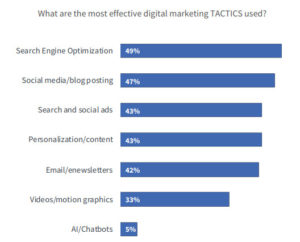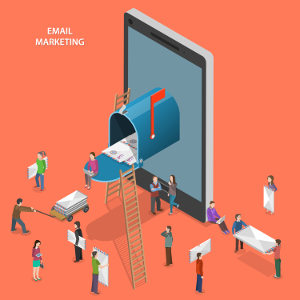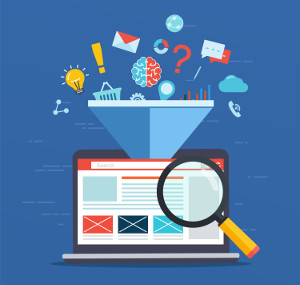Website Marketing Overview – Who What When Where Why & How
Everyone tells you how you should be marketing your business website. Your brother said you should be posting on social media.  Your sister told you you need to focus on SEO. Your cousin insists that email marketing is the only way to go. What’s your problem? These people are all experts, just ask them. If you did everything they all say you wouldn’t have time to run your business. Does digital marketing even make sense for your business?
Your sister told you you need to focus on SEO. Your cousin insists that email marketing is the only way to go. What’s your problem? These people are all experts, just ask them. If you did everything they all say you wouldn’t have time to run your business. Does digital marketing even make sense for your business?
Why is digital marketing so important? Most marketers (87% according to survey), believe digital / online marketing is more effective than traditional marketing methods.
Website marketing can be an overwhelming topic. Every day we hear about the latest, greatest techniques. In this article we are going to simplify the topic and cover the basics: 1) What is website marketing? 2) An overview of the different marketing strategies and tactics. 3) How to choose the right strategies and tactics for marketing your business website. 4) How to get started with business website marketing.
What is Website Marketing?
Website marketing is the promotion of a website to increase the number of people who visit and encourage them to interact with the content of the site. For a business, effective website marketing also drives some type of transaction. Businesses marketing to other businesses and businesses marketing high dollar consumer purchases (such as a car, real estate or financial services, etc.), often view generating a new lead as the primary goal transaction. Businesses that primarily sell to consumers most often see an actual purchase as the primary goal transaction.
In a survey by Ascend2, where 300 professional marketers were asked about their marketing plans for 2020, increasing sales leads, and increasing customer acquisition were the two top goals for digital marketing. The most important concept here is generating traffic that produces the type of transaction you desire from your business website.
Overview of Website Marketing Strategies and Tactics
This list is an introduction to the strategies and tactics used in website marketing. It is not intended to be comprehensive. Over time, in other articles, we will cover many of these topics in detail. If there is a particular topic you would like us to write about or to get more information on, please submit it in the comments below, or in a contact form.
We’re going to focus on the top marketing tactics professionals say produce the best results:

The list, in order of reported effectiveness and perception as one of the most effective tactics includes: Search Engine Optimization (SEO) at 49%, Social Media / blog posting at 47%, Search and Social ads (PPC) at 43%, Personalization / Content at 43%, email / newsletters at 42%, and videos / motion graphics at 33%.
Unfortunately even this survey can create confusion because many of the tactics overlap. For instance, personalization / content, can also be included as part of SEO. So can the blog posting element of social media / blog posting. To make the overview more concise and relevant to those just starting with website marketing we’re going to simplify things into fewer categories of digital marketing tactics.
The five categories we are going to cover are Search Engine Optimization, Social Media (Social media / blog posting), Paid Online Advertising (search and social), Email (Email / enewsletters), and Video Marketing (Videos / motion graphics).
Know Your Potential Customers
Before we begin the discussion I want to emphasize something that is important regardless of the marketing tactic you use. Know who your potential customers  are. You should know as much about them as you can before you begin marketing. It will make all your efforts much more effective and rewarding. You can’t target what you can’t find. If you know who your customers are and what they like, you will be able to reach them better using any of these tactics. In marketing this is called creating a buyer persona. If you would like more information on creating buyer personas check out this beginner’s guide article on creating marketing personas on Buffer. It gives you the basics you need to get started defining your existing and most likely customers.
are. You should know as much about them as you can before you begin marketing. It will make all your efforts much more effective and rewarding. You can’t target what you can’t find. If you know who your customers are and what they like, you will be able to reach them better using any of these tactics. In marketing this is called creating a buyer persona. If you would like more information on creating buyer personas check out this beginner’s guide article on creating marketing personas on Buffer. It gives you the basics you need to get started defining your existing and most likely customers.
Search Engine Optimization (SEO)
Search engine optimization is the process of increasing the quality and quantity of website traffic by increasing the visibility of a website or a web page to users of a web search engine. (Wikepedia SEO Definition) SEO includes, and is sometimes used interchangeably with the terms Inbound Marketing, Content Marketing, Blogging, and others.
SEO is probably the most beloved and hated digital marketing tactic of them all. If your website SEO is done well, you will reap the benefits of an often enormous amount of relevant, transaction ready traffic. The tough part about relying on SEO to drive website marketing is that many of your competitors are also trying to get this traffic. If you are in a competitive field it can seem like an impossible task to rank.
The good news is that SEO is not difficult to start. If you create good, relevant content for your prospective customers, the search engines will find it. It may take some effort to rank for the specific keywords your customers are searching for, but you will begin to see traffic once you begin creating relevant content.
for, but you will begin to see traffic once you begin creating relevant content.
Another good place to start with SEO for some businesses is Local SEO. This is the practice of getting your business listed in Google MyBusiness, and a variety of other directories as well as ensuring that geographic words and phrases are included with your product and service keywords on the same pages. For instance, if you are selling widgets in Los Angeles, you would want to make sure that pages on your site had both the words widgets, and Los Angeles in the same paragraph. For many small, local businesses, Local SEO generates the majority of their new customers.
If you are in a competitive field, SEO tactics become more complicated to execute. The strategies include external backlink building (getting other authoritative websites to link to your content), citation building, etc. Good places to acquire more information on advanced SEO techniques include: Moz, and Search Engine Journal.
The most important takeaways for those new to website marketing are: create relevant content for your potential customers, and get your business listed with links to your website in the appropriate places.
Social Media Marketing

Social media marketing is the use of social media platforms to connect with your audience to build your brand, increase sales, and drive website traffic. (Buffer Definition)
Social Media Marketing seems to be the subject of almost every digital marketing conversation. We hear conversations about memes that went viral and how they affected a particular business. If you can engage your target customers in social media and find a way to encourage them to share and promote your business you can experience amazing results.
The benefits of social media marketing are great, but to properly execute the strategies and tactics involved can be a lot of work. It’s important to create a consistent presence and engage with your potential customers. Give them the information & interaction they are looking for and they can help you promote your business.
The most key to starting a social media marketing strategy begins with setting up accounts on the most appropriate social media for your type of business. For consumer brands these usually start with Facebook and Twitter. For business to business brands the starting point is often LinkedIn. When choosing which social media platforms are appropriate for your business you should also take into consideration your potential customers. Different people in different age, income, and other demographic segments use different social media platforms in different ways.
Once you’ve set up your social media accounts, make sure you properly set up your business pages. Then begin posting on topics your potential customers consider relevant to them. Search for other people and businesses that are posting on topics similar to yours and use tags to highlight them. There is research that shows posts with hashtags receive more engagement than those without. Often when others see you tagging them in your posts they will follow you and tag yours in theirs.
The most important takeaways for social media marketing are to find and set up accounts on appropriate social media platforms, post consistently, and do your best to engage others.
Paid Online Advertising (PPC)
Pay-per-click (PPC), also known as cost per click (CPC), is an internet advertising model used to drive traffic to websites, in which an advertiser pays a publisher (typically a search engine, website owner, or a network of websites) when the ad is clicked. (Wikepedia Definition)
Most people think of pay per click advertising as the listings on the top of the search results in search engines. Today pay per click advertising is everywhere  you go online. Many businesses focus their online advertising budgets on social media PPC vs. search PPC. There is a different type and variety of online advertising for almost any business. For companies that sell to other businesses this may include LinkedIn, trade organization websites, trade publications, or any other of a wide variety of appropriately targeted sites.
you go online. Many businesses focus their online advertising budgets on social media PPC vs. search PPC. There is a different type and variety of online advertising for almost any business. For companies that sell to other businesses this may include LinkedIn, trade organization websites, trade publications, or any other of a wide variety of appropriately targeted sites.
The primary benefits of paid online advertising include the ability to target your potential customers very specifically. If you know your customers like to hike outdoors, you can place ads on sites, forums, or social media groups that talk about hiking. If your customers are purchasing or human resource managers at companies, you can find specific sites that they visit as well. You can target the specific keywords people would use to find your products or services and not have to worry whether you were able to rank using SEO. You can promote a special offer when that offer is ready, you don’t have to wait for it to appear in search or for someone else to begin discussing it. The downside is you have to pay to get this traffic. If you manage it properly, the upside is that you get the traffic you want, when you want it.
PPC advertising crosses many of the borders between the other types of website marketing. For example, you can advertise in someone’s enewsletter, on with videos, on top of search results, on social media to promote your own social media, etc. The most important thing to remember with PPC advertising is to track everything you do. If you know what you are spending your advertising budget on, and how it is performing, and reallocating funds as appropriate, you can be successful.
Key takeaways for paid online advertising include: Find and target the places your customer visit online and the keywords they use to search for your products and services. Track everything and make adjustments as necessary.
Email Marketing
Email marketing is the act of sending a commercial message, typically to a group of people, using email. In its broadest sense, every email sent to a potential or  current customer could be considered email marketing. It usually involves using email to send advertisements, request business, or solicit sales or donations, and is meant to build loyalty, trust, or brand awareness. (Wikipedia Definition)
current customer could be considered email marketing. It usually involves using email to send advertisements, request business, or solicit sales or donations, and is meant to build loyalty, trust, or brand awareness. (Wikipedia Definition)
Email marketing is arguably one of the most effective website marketing tactics. The difficulty with email marketing in the beginning is developing an appropriate list of potential customers to send emails to.
It was relatively common for companies to send out unsolicited email blasts to large lists they had purchased from other companies. Now this is relatively rare because of the negative impacts this practice created. Most people don’t mind receiving some emails from companies they are familiar with and have opted in to receive but they do not want to receive hundreds of spam emails from people or companies they have no interest in.
Developing a good, targeted email list enables successful email marketing. There are many ways of building email lists that are appropriate for different types of potential customers. Some of these include contests and promotions, collecting contact information at networking events, offering products, services, promotional offers, etc. in exchange.
Once you have built your email list there are many different email newsletter service providers you can use to help you develop and send your emails. Some of the most well known include Constant Contact and Mailchimp.
If you are setting up an email newsletter, it’s often beneficial to set up a regular schedule to send them out. Be careful not to send too many emails within a short period of time. You can still occasionally send special offers and promotions outside the normal newsletter. Having a regular schedule for the newsletter will ensure regular communication and help prevent sending too many.
Some best practices with email marketing include using a CRM (Customer Relationship Management) software to enable the tracking of and interaction with customers. This is especially true when you are engaging with customers and potential customers by email outside the newsletter.
Emails are a good place to build customer relationships and make special offers to existing customers. Customers often keep old emails with promotions, offers, and business contact information to use as a reference in the future.
Important takeaways from email marketing include developing a targeted opt-in list of potential customer emails, organize and track interaction.
Video Marketing
Video marketing is a type of marketing strategy that uses videos to help companies reach, educate and entertain their target audience. (Drift Definition)
Why is video marketing important? According to Cisco video traffic will make up  82% of all IP traffic by 2022. 17% of all traffic will be live video. Your customers want video. Most people will watch a video when they won’t take the time to read an article. Video has its own search results in Google.
82% of all IP traffic by 2022. 17% of all traffic will be live video. Your customers want video. Most people will watch a video when they won’t take the time to read an article. Video has its own search results in Google.
Video gets and holds peoples attention. There are many different types of marketing videos: explainer videos, product demonstration videos, unboxing videos, corporate profile videos, etc. There are many ways to present your company, products, and services in videos to your potential customers.
Now making videos is easier than ever. It can be as simple as starting with a webcam or your cell phone or you can hire a professional video production company.
Now that you have begun developing videos, the easiest way to start using it to promote your business is to set up a Youtube Channel. After you’ve set up your Google account and youtube channel you can begin posting your videos. Make sure you include keywords your customers would use to search for your products and services in the title and description of your video so they can find them when they search.
Video can also be used in online advertising, for search engine optimization, in enewsletters, and social media. Its an amazing tool that will produce results if you take the time and effort to create and promote.
Key takeaways from video marketing include: start creating video content, setup a Youtube Channel, and use appropriate keywords when submitting videos.
Website Marketing Summary
Even after we tried to simplify the marketing tactics discussed above I realized that it may still be a bit overwhelming. The most important thing you can do to market your business is to pick at least one tactic and get started.
If you are having trouble deciding which tactic to pick to start, then start by setting a goal. Each of the different tactics has its own advantages. Some of them  might be a better fit for the goals you have in mind. For example, online advertising allows you to see much faster results than search engine optimization. Search engine optimization often drives more traffic in the long term. Video marketing is a great way to sell a complex product or service because you can show someone how it’s used. Email marketing is an excellent tool for reengaging previous customers and driving incremental sales. Social media helps you reach people like your existing customers and makes it easier and more convenient for them to help promote your business.
might be a better fit for the goals you have in mind. For example, online advertising allows you to see much faster results than search engine optimization. Search engine optimization often drives more traffic in the long term. Video marketing is a great way to sell a complex product or service because you can show someone how it’s used. Email marketing is an excellent tool for reengaging previous customers and driving incremental sales. Social media helps you reach people like your existing customers and makes it easier and more convenient for them to help promote your business.
Marketing a business website can be one of the most profitable efforts a company makes. All of the tactics we’ve discussed will work and drive more business to your website if you put in the time and effort.
If you have any questions about the topics please feel free to leave a comment below.
For help with developing and implementing a marketing strategy please contact us.

Great article! 82% of all traffic will be video?? That’s an amazing stat!
I agree, video is having a huge impact on all types of online marketing. Good video enables good engagement.
Great article on the various website marketing strategies. You clearly have a wealth of information to share that is of benefit to all kinds of companies. Well done.
Thank you. We will be adding a variety of more in-depth marketing content for small businesses in the future. If there are any topics you would like us to discuss, please let us know.